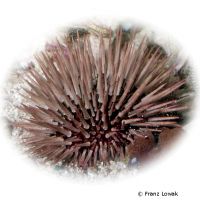Rock-boring Urchin (Echinometra mathaei)
| Rock-boring Urchin Echinometra mathaei | |
|---|---|
| Name | Rock-boring Urchin |
| Name Lat. | Echinometra mathaei |
| Family | Echinometrid Sea Urchins |
| Family lat. | Echinometridae |
| Order | Sea Urchins |
| Order lat. | Camarodonta |
| Origin | Indo-Pacific |
| Diet | Limnivore |
| pH | 8.1-8.4 |
| Hardness | 8-12 °KH |
| Lighting | Medium |
| Current | Moderate |
| Behavior | Peaceful |
| Keeping | Individual |
| Care Level | Moderate |
| Life Span | N/A |
| Protection | No |
| Metric Units | |
| Size | 10 cm |
| Temperature | 22-27 °C |
| Salinity | 33-36 ‰ |
| Aquarium | 200 l |
| US Units | |
| Size | 3.9" |
| Temperature | 72-81 °F |
| Salinity | 1.020-1.025 sg |
| Aquarium | 50 gal |
Distribution and habitat
Echinometra mathaei are widely distributed in the Red Sea and Indo-Pacific to Hawaii and Samoa. They live in the uppermost coral reef areas, in the shallow, current-rich waters of the surf zone at depths of 1-3 m, where they settle in burrows and crevices.
Maintenance
They need a well structured aquarium with rock structures that provide caves and crevices where they can retreat during the day, as well as stably anchored live rocks for grazing (algae) and that act as a biological filter
Only lime-rich, heavy metal-free substrates may be used as substrate. Filters, skimmers and heaters are necessary to ensure water quality, as well as pumps to simulate tides, swells and bottom currents. Lighting must match the species-appropriate day-night rhythm of the animals
| Salinity: 33-36 ‰ | pH value: 7.9-8.5 |
| Carbonate hardness: 6-10 °KH | Nitrate content: 2-8 mg/l |
| phosphate content: 0.01-0.1 mg/l | nitrite content: 0.0-0.05 mg/l |
Regular addition of trace elements, especially calcium, iodine and magnesium is recommended. For salinity, an average value should be aimed for, which may only vary slightly by +/- 0.5 ‰. Ammonia and ammonium must not be measurable. Special attention shall be paid to consistently good water quality and water values.
Diet
In nature they feed mainly on algae. The nocturnal animals graze algae from rocks and substrate, also rasping off calcareous algae as well as incrustated invertebrates such as sponges, bryozoans etc.. Detritus is also part of their food spectrum. If algae growth is too low, it is necessary to feed commercial food, such as dried seaweed (Porphyra umbilicalis) and algae leaves (Norialgen), as well as protein-rich algae-based food tablets, to prevent attacks on sessile invertebrates
When scraping, they absorb the lime from rocks and substrate necessary for their skeletal structure. However, additional soft lime, such as cuttlebone, should be offered to ensure an adequate supply of vital lime
Behaviour and compatibility
In nature they usually live individually. In a large, richly structured aquarium with sufficient food supply (algae), several animals can be kept together. A socialization with fish and robust invertebrates, by which they are not considered food, is well possible.
Reproduction and breeding
They are separately sexual and have no external sexual characteristics. Eggs and sperm are released into the surrounding water. The resulting larvae are part of the plankton for several weeks until they turn into small sea urchins
There are no known reports of successful breeding in the aquarium.
Important
In nature, the brown to black-brown colored sea urchins drill cavities in rocks with their mouth teeth and spines. In the aquarium they can move rocks or cause unstable superstructures to collapse
Care must be taken when moving them. Sea urchins must not be allowed to come up for air, as air bubbles can form in their water-filled respiratory system, which would lead to suffocation.
Stinging injuries can be very painful and result in inflammation.
If different species are kept together, care should be taken to match fish and invertebrates in terms of water quality and temperature requirements, as well as their social behavior, and to ensure that the setup meets the ecological needs of all species kept together. Newly introduced animals must be acclimated slowly to the water in the aquarium
Further literature can be found in your pet store.
References
Text: Werner Winter; Image: Franz Lowak
Source: FOSSÁ & NILSEN (1995): Korallenriff-Aquarium Bd. 6, Birgit Schmettkamp Verlag; ENGELMANN & LANGE (2011): Zootierhaltung - Tiere in menschlicher Obhut: Wirbellose, Verlag Harri Deutsch; ERHARDT & MOOSLEITNER (1997): Meerwasser Atlas Bd. 3, Mergus Verlag
